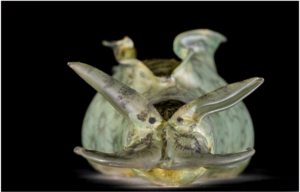Mystic Seaport Museum Presents Spineless: A Glass Menagerie of Blaschka Marine Invertebrates
MYSTIC SEAPORT MUSEUM PRESENTS
SPINELESS: A GLASS MENAGERIE OF BLASCHKA MARINE INVERTEBRATES
OPENING OCTOBER 21, 2023
ON VIEW THROUGH SEPTEMBER 2024

Blaschka glass model of the gastropod mollusk, Aplysia argus. Museum of Comparative Zoology, Harvard University, MCZ: SC:330, Syphonota viridescens. © President and Fellows of Harvard College. Photograph by Joe Michael.
Mystic, CT. [TK, 2023] – Mystic Seaport Museum is pleased to present Spineless: A Glass Menagerie of Blaschka Marine Invertebrates, a major exhibition featuring selections from the 19th-century Blaschka Glass Invertebrates collection at The Museum of Comparative Zoology at Harvard and from other institutions. The exhibition features over 40 of the exquisite models, and is the first to emphasize models which are now identified as introduced species, including many now found in New England waterways. Co-curated by Krystal Rose, Curator of Collections at Mystic Seaport Museum and Dr. James T. Carlton, Director Emeritus of the Williams-Mystic Coastal and Ocean Studies Program, Spineless will be on view October 21, 2023 through September 2024, highlighting both the history of 19th-century science and the study and tracking of marine introduced species in the wake of globalization.
“Spineless provides a rare opportunity to see the world-famous Blaschka models in a new context, interpreted through the lens of maritime and marine science histories and connecting the past with the present,” said Christina Connett Brophy, Senior Director of Museum Galleries and Senior Vice President of Curatorial Affairs at Mystic Seaport Museum. “Using the Museum’s own collections as well as some exquisite loans from the Museum of Comparative Zoology at Harvard University and others, the Blaschka models come alive with themes that relate to other exhibitions and programs throughout the campus and our unique site along the Mystic River.”
The exhibition highlights the intriguing story of father and son glassmakers Leopold and Rudolf Blaschka of Dresden, Germany. In the 1850s, the elder Blaschka became fascinated by invertebrates he observed while at sea. After a successful commission to create sea anemone models for a nearby natural history museum, Leopold and later on his son, Rudolf, went on to produce glass models of hundreds of marine invertebrates. The glasswork of the Blaschkas beautifully captured the forms, anatomical details, and colors of these magnificent sea creatures. Through a mail-order business, they successfully sold and distributed these often extraordinarily fragile pieces to museums and universities around the world for teaching and display purposes.
When creating the models, the Blaschkas relied on their relationships with scientists, along with observations of live specimens held in aquariums, wet specimens, books, and scientific journals. In Spineless, selected models are accompanied by sailors’ journals and rare books containing sketches, watercolors, written descriptions, and photographs, giving a glimpse into early documentation and scientific work at sea. Wet specimens, preserved in jars, highlight the challenges that the Blaschkas and scientists faced in preserving and documenting invertebrates for study. These historic objects are complemented by depictions of marine invertebrates by contemporary artists, demonstrating our enduring interest in these remarkable, often mysterious creatures.
A special presentation within Spineless turns an eye towards some of the invertebrates’ modern-day environmental impact as introduced species. Since the models’ creation in the late 19th century, some of the species they represent have been introduced around the world, traveling on the hulls of ships and in ballast water. Those models are singled out and contextualized through the work of co-curator Dr. James T. Carlton, one of the world’s leading experts in marine bioinvasions. In Carlton’s own words, “the Blaschka glass models elegantly illustrate the absence of any boundaries between art and the science of the sea, including our modern-day environmental concerns for ocean conservation.”
Spineless: A Glass Menagerie of Blaschka Marine Invertebrates marks the continuation of the Museum’s educational initiatives on introduced species in the context of maritime history, which began with the currently-on-view Alexis Rockman: Oceanus. A new series of waterfront panels on introduced species, Spineless, and Oceanus will highlight many of the same invertebrates created by the Blaschkas in a contemporary context.
Spineless: A Glass Menagerie of Blaschka Marine Invertebrates will be accompanied by various programs and lectures throughout the duration of the show.
About Mystic Seaport Museum
Mystic Seaport Museum is the nation’s leading maritime Museum. Founded in 1929 to gather and preserve the rapidly disappearing artifacts of America’s seafaring past. The Museum has grown to become a national center for research and education with the mission to “inspire an enduring connection to the American maritime experience.” The Museum’s grounds cover 19 acres on the Mystic River and include a recreated New England coastal village, a working shipyard, formal exhibit halls, and state-of-the-art collection storage facilities. The Museum is home to more than 500 historic watercraft, including four National Historic Landmark vessels, most notably the 1841 whaleship Charles W. Morgan.
For more information, please visit mysticseaport.org and follow the Museum on Facebook, Twitter, YouTube, and Instagram.
The Museum is open daily 10:00 am–5:00 pm through October 30 and daily 10:00 am–4:00 pm from October 30 through December 31.
Media Contacts:
For images, further background or interviews, please contact:
Chloe Pingeon
Account Coordinator, Visual Arts
Blue Medium
T: +1-212-675-1800
chloe@bluemedium.com
Sophia Matsas
Director of Marketing & Communications
Mystic Seaport Museum
T: +1-860-572-5317
sophia.matsas@mysticseaport.org